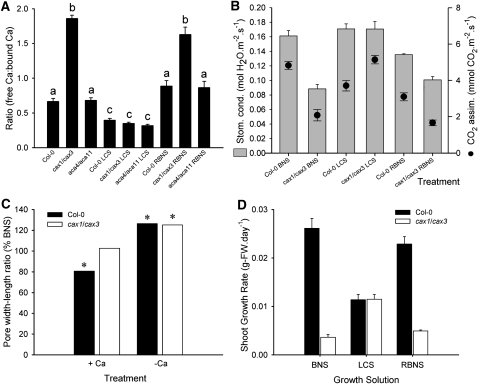Figure 3.
Slow Growth, Low Transpiration, Reduced Photosynthesis, and Guard Cell Aperture Phenotypes Can Be Conditionally Suppressed by Ca Starvation in the cax1/cax3 T-DNA Insertion Mutant.
(A) Apoplastic calcium concentrations of Col-0, aca4/aca11, and cax1/cax3 plants presented as the ratio of free Ca to bound Ca (SeCa:BeCa, sorbitiol-extractible Ca:barium-extractible Ca). Measurements performed on 6-week-old Arabidopsis plants grown for 7 d prior in BNS or LCS (50 μM aCa) and subsequently returned to BNS (RBNS) for an additional 7 d. Data presented as mean ratio + se (n = 6 leaves per genotype per condition). Three replicate samples each comprising leaves from two plants performed across three experiments. a, b, and c represent no statistical difference between each treatment (ratio calculated between leaves of the same plant, permitting statistical analysis on biological replicates by two-way ANOVA, P < 0.05).
(B) Stomatal conductance (gS; mean + se) and CO2 assimilation rates (A; mean ± se) of leaf 8 of 7-week-old Col-0 and cax1/cax3 plants in BNS, LCS (from week 6), and RBNS (LCS from week 5, BNS from week 6). n = 5 plants per genotype per treatment, with experiment repeated five times with identical trends.
(C) Guard cell aperture of epidermal strips from Col-0 and cax1/cax3 plants floated on DS. Data presented as the aperture ratios on high calcium solution (+Ca; 1 mM) or in the presence of EGTA to chelate calcium (−Ca) as a percentage of apertures of each respective phenotype incubated solely on DS. Student’s t test was performed on raw data; asterisk indicates statistical significance from treatment compared with Col-0 in BNS (P < 0.05). For replicate number, refer to the main text.
(D) Changes in shoot biomass of Col-0 and cax1/cax3 plants during 7 d growth in BNS followed by transfer and a further 7 d growth in LCS and then return to BNS for a further 7 d (RBNS). Data presented as mean growth rate + se (n = 6 plants per treatment).

